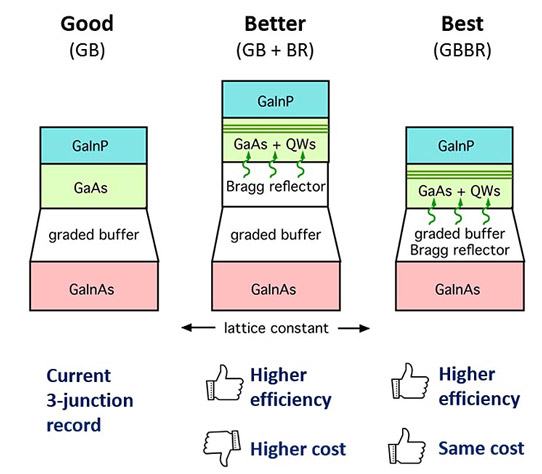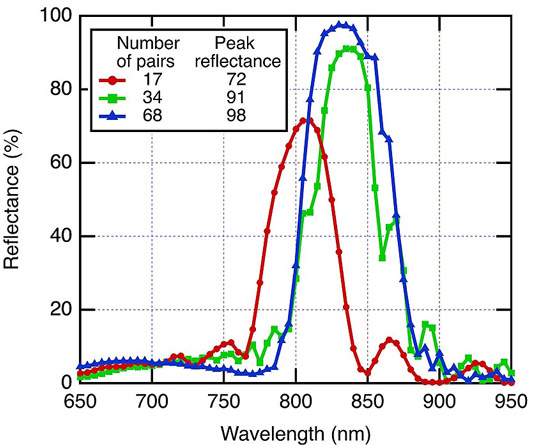- News
15 October 2018
NREL, Caltech and UNSW combine Bragg reflector structures within graded buffer for lower-cost, higher-efficiency multi-junction solar cells
© Semiconductor Today Magazine / Juno PublishiPicture: Disco’s DAL7440 KABRA laser saw.
The US National Renewable Energy Laboratory (NREL) of Golden, CO, USA has combined two structures of III-V materials into one to provide significant cost savings. The combination has already enabled novel, potentially record-setting, multi-junction solar cells, consisting of several thin subcells of absorbing materials with differing physical, electrical and optical characteristics stacked atop each other (to generate electricity more efficiently than single-junction devices such as silicon solar cells).
The two structures — a graded buffer and a Bragg reflector — are both already used independently in solar cells and lasers. Integrating them into one, dual-purpose structure allows devices to gain functionality without extra cost, but it requires some design work.
Better designs through innovation
Graded buffers (GBs) are used to match up different-sized crystal lattice constants within a III-V device, which allows designers to access materials with a whole host of diverse properties, such as a material’s bandgap — determining the wavelength of light emitted by a light-emitting diode (LED) or laser and the wavelengths most efficiently absorbed by solar cells and detectors. Integrating materials with different lattice constants and bandgaps into a single III-V multi-junction solar cell has enabled many previous record devices, such as a three-junction inverted metamorphic device with 37.9% efficiency under the 1-sun global spectrum (shown in the left side of Figure 1).

Figure 1. The graded buffer Bragg reflector (GBBR), which combines two complex structures (GB and BR) into one thinner unit, enabling novel multi-junction devices that may surpass existing efficiency records with similar cost.
Bragg reflectors (BRs) allow selected wavelengths of light to be reflected and are commonly used in laser devices to create an optical cavity. In multi-junction solar cells, Bragg reflectors reflect light back into an adjacent subcell, which is particularly useful for materials that do not fully absorb the incoming light, such as very thin subcells or thin quantum-well layers (absorbing layers with a low bandgap). In theory, higher efficiency is possible with the structure in Figure 1 (middle figure), involving quantum wells to lower the middle-cell bandgap, a BR to increase absorption, and a GB to access lattice-mismatched GaInAs. However, both BRs and GBs are relatively thick layers of the device and are expensive to make. So, these structures come with the drawback of additional cost.
In recent work, Ryan M. France, Harvey Guthrey, Myles A. Steiner and John F. Geisz of NREL; Pilar Espinet-González of Applied Physics and Materials Science, California Institute of Technology (Caltech); and Nicholas J. Ekins-Daukes of the School of Photovoltaic & Renewable Energy Engineering, University of New South Wales (UNSW) in Australia, combined a GB and BR into one structure - a graded-buffer Bragg reflector (GBBR). The GBBR is thinner than an independent GB and BR and enables a multi-junction structure with higher potential efficiency than the existing record device, but without an increase in cost (shown in the right side of Figure 1).
“III-V materials have been studied and used for solar purposes for a long time—for at least 50 years. So as a materials scientist, I’m excited that we are still innovating new III-V materials and concepts that enable novel device structures,” says NREL’s Ryan France, lead author of ‘Multijunction Solar Cells with Graded Buffer Bragg Reflectors’ (IEEE Journal of Photovoltaics; DOI: 10.1109/JPHOTOV.2018.2869550).
The team studied the performance of the GBBR and integrated it into this novel multi-junction structure. Initial three-junction devices already achieve 36.5% efficiency under the AM1.5 global spectrum and 32.4% efficiency under the AM0 space spectrum, which is one of the highest reported efficiencies for a three-junction device under the 1-sun AM0 spectrum.
“Our upcoming plans use a similar device to target the development of a three-junction cell that will reach 40% power conversion efficiency under the global spectrum — which is about 2% absolute better than the current record efficiency,” says co-author Myles Steiner.
Branching into other applications
Over its more than 40-year history, NREL has amassed experience in designing, fabricating, characterizing and testing III-V multi-junction solar cells. Applying this new GBBR to such solar cells has been a natural strategy.
But, as often happens, innovations in one field can directly benefit other fields. GBs access materials with a variety of bandgaps, enabling LEDs and lasers with a variety of emission wavelengths. Using a GBBR instead of a GB adds a reflector directly behind an LED or laser, which could enhance the power output or reduce the cost of these emitting devices.
In their study targeting multi-junction solar cells, the team developed a GBBR with 98% reflectance by increasing the refractive-index contrasting pairs, which provide the reflection in a BR (shown in Figure 2). This reflectance may also be useful in vertical-cavity surface-emitting lasers (VCSELs), where it is difficult to place a metal reflector next to the optical cavity. BRs in these laser structures currently provide super-high-reflectivity (99.9%) alternatives to metals, and the GBBR may be useful in longer-wavelength metamorphic lasers if such a high reflectivity can be achieved.

Figure 2. Reflectance from three graded buffer Bragg reflectors with a varied number of contrasting refractive-index pairs.
In other solar-related applications, GBs and BRs are being considered as a means to mitigate radiation damage on solar devices in outer space. The advances by NREL, UNSW and Caltech in combining GB and BR functions into a GBBR will therefore likely be of interest for enhancing the operational performance of space solar cells. Currently, NREL has a patent pending on the GBBR technology and hopes to make the technology available for licensing in the near future.
https://ieeexplore.ieee.org/document/8477025


